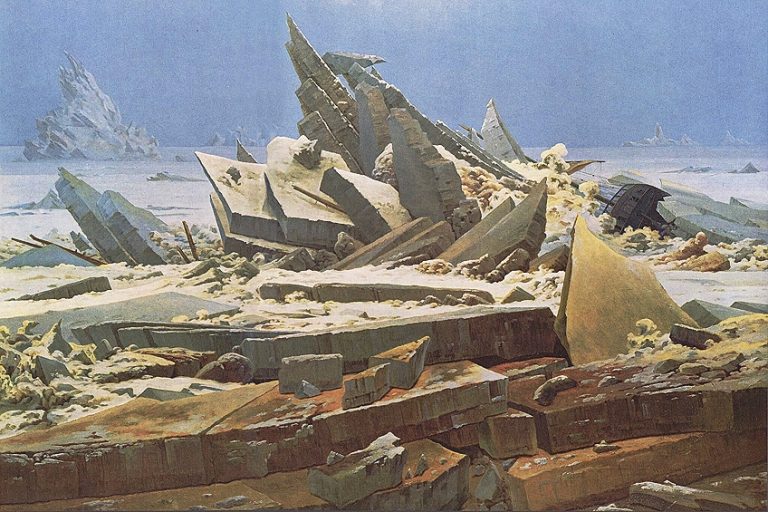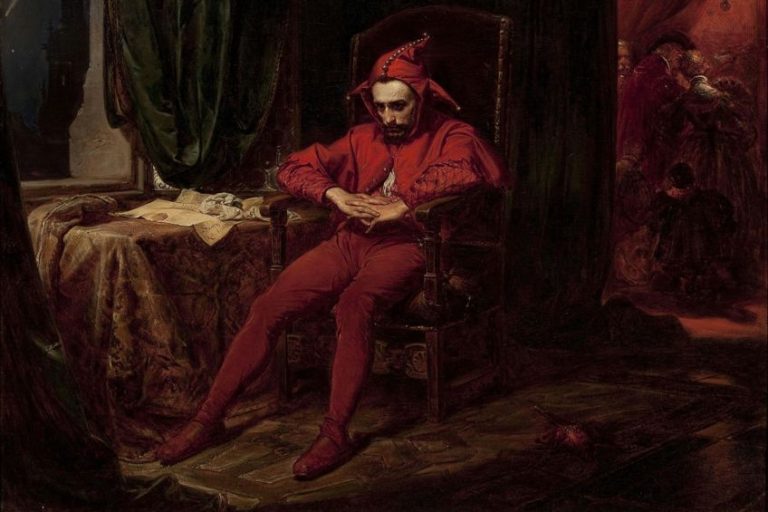“Irises” by Vincent van Gogh – Studying the Famed “Irises” Painting
Irises (1889) was part of a series of iris flower paintings by the world-renowned and loved Post-Impressionist artist, Vincent van Gogh. This article will explore and discuss this painting in more detail, providing both a contextual and formal analysis.
Table of Contents
Artist Abstract: Who Was Vincent van Gogh?
Vincent Willem van Gogh was a Dutch painter best known as a Post-Impressionist. He was born in Zundert, which is a town in the North Brabant province in the Netherlands. His birth and death dates were from March 30, 1853, to July 29, 1890, respectively. He lived for 37 years and experienced a mental illness that caused him significant hardships throughout his life.
He was in close correspondence with his brother Theo van Gogh, who also financially supported him. Over the years, Van Gogh produced hundreds of drawings and paintings, some of which include The Potato Eaters (1885), The Night Café (1888), and The Starry Night (1889).
However, it was only after Vincent van Gogh died that he achieved fame.
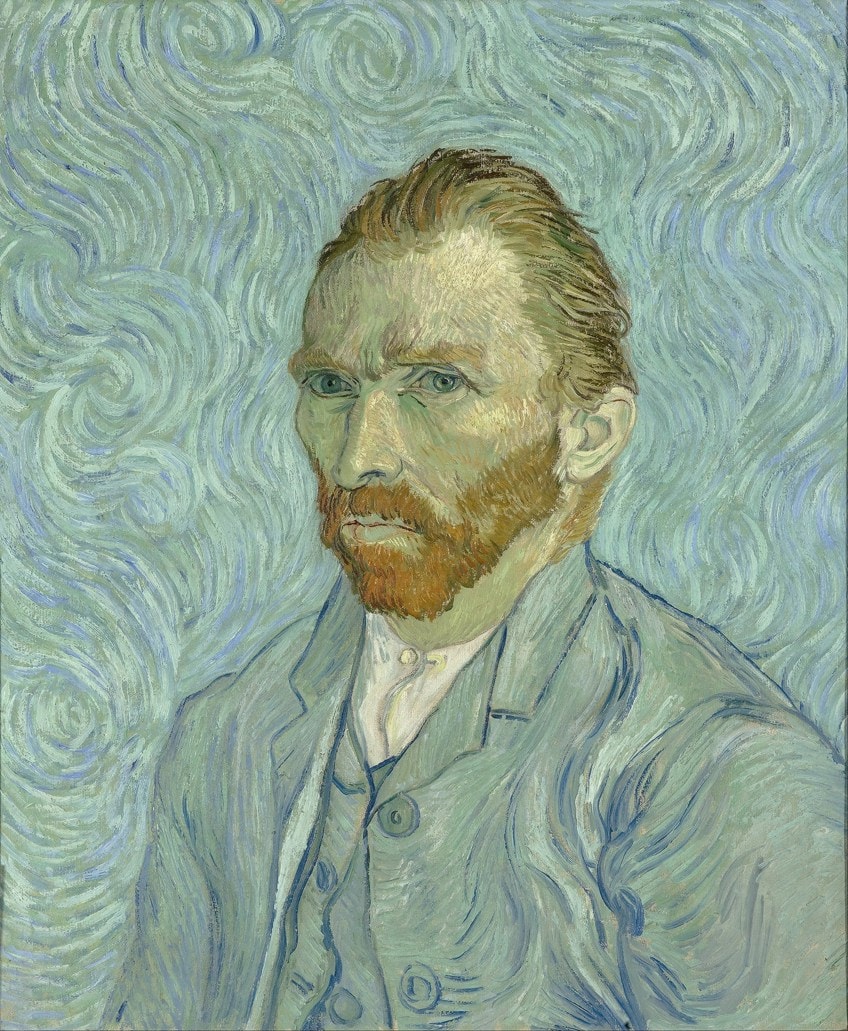
Irises (1889) by Vincent van Gogh in Context
In the article, we will discuss the oil on canvas titled Irises by Vincent van Gogh, and notably where he was when he painted it and what inspired him. Through a formal analysis, we will take a closer look at the subject matter and Van Gogh’s techniques through the lenses of the art elements and principles.
| Artist | Vincent van Gogh (1853 – 1890) |
| Date Painted | 1889 |
| Medium | Oil on canvas |
| Genre | Landscape |
| Period / Movement | Post-Impressionism |
| Dimensions (cm) | 74.3 x 94.3 |
| Series / Versions | Part of a series of four iris paintings |
| Where Is It Housed? | J. Paul Getty Museum, Los Angeles, California, United States of America |
| What It Is Worth | Sold in 1987 for $53.9 million at a Sotheby’s auction to Alan Bond, who returned it due to insufficient funds. It was then purchased by the J. Paul Getty Museum in 1990, but the price was not disclosed. |
Contextual Analysis: A Brief Socio-Historical Overview
When Vincent van Gogh painted Irises, he was living in Saint-Rémy-de-Provence, which is in southern France, specifically at the asylum called Saint Paul de Mausole. He stayed there from May 1889 to May 1890 due to mental health difficulties and breakdowns; he reportedly admitted himself.
In February 1888, before Van Gogh entered the asylum, he lived in Arles, which is a city in the south of France. Here, he lived at the famous Yellow House, where he produced a prolific collection of artworks. He also notably shared the house with Paul Gauguin from October to December 1888.
It was during this period that Van Gogh cut off what was believed to be part of his ear, and the artistic duo between him and Gauguin was broken off.

Following the above-mentioned event, Vincent van Gogh reportedly stayed, on several occasions, at a hospital in Arles. He had numerous bouts of mental breakdowns, which caused unseemly behavior until he moved to the Saint Paul asylum in May. While Van Gogh stayed at Saint Paul, he painted in a separate room converted into a studio.
This was also a creative period for him, and he was inspired by the beauty of the asylum’s garden and surrounding landscape. Van Gogh reportedly produced over 100 paintings while he was there.
The Irises Series
The Irises painting was reportedly painted a week into Van Gogh’s admittance to Saint Paul and he produced four renditions, or what has been described as “studies” of irises but notably also of colors. The four iris paintings are namely, Irises (1889), which is the painting that will be discussed in the formal analysis below, as well as The Iris (1889), Still Life: Vase with Irises (1890), and Still Life: Vase with Irises Against a Yellow Background (1890).
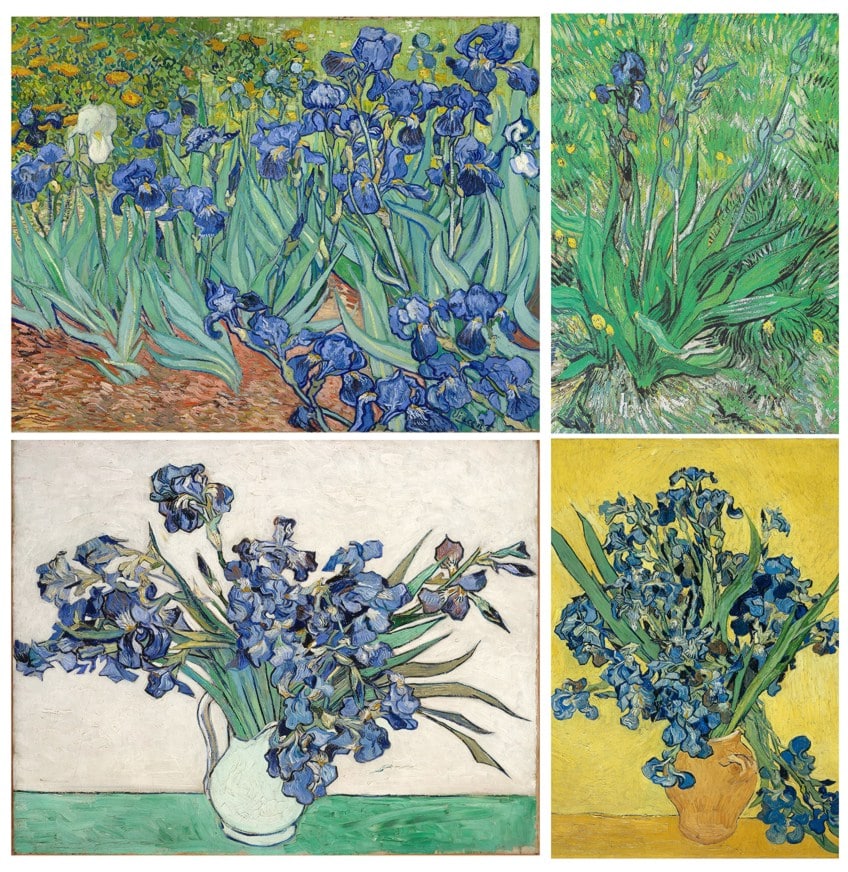
Exhibiting the Irises Painting
Vincent van Gogh’s brother, Theo van Gogh, sent the Irises painting in to be exhibited at the Salon des Indépendants, which was in September 1889. He has often been quoted when describing the painting and what it looked like at the exhibition, stating in a letter to Vincent van Gogh that it “strikes the eye from afar” and that it is a “beautiful study full of air and life”.
Interestingly, at the same exhibition, Vincent van Gogh’s “Starry Night Over the Rhône” (1888) was also on display, however, Theo van Gogh stated that it was not hung properly and was difficult to look at from afar due to the narrow room.
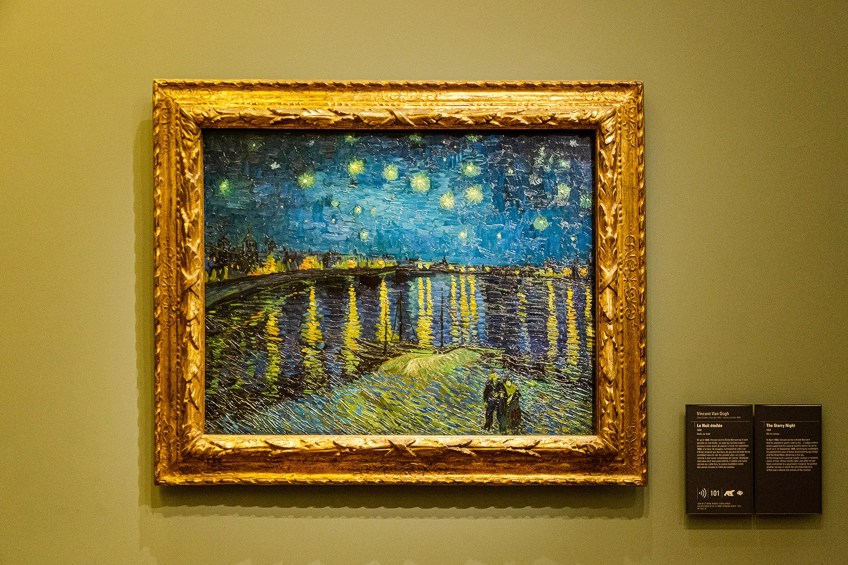
Influences: Japanese Prints
Vincent van Gogh was influenced by the stylistic techniques of the Ukiyo-e woodblock prints; he was also a collector. It was a Japanese style of art during the 1600s to 1800s, which expanded to the western countries in America and Europe and was known as “Japonism”.
Some of the main features of this style included subject matter like fauna and flora, usually landscapes, as well as people from various walks of life. The compositions have been characterized as having flat spaces and colors, and subject matter would be cropped and placed at angles, which would create more dynamism and emphasis.
This style of Japanese art is seen in some of Vincent van Gogh’s other paintings like Bridge in the Rain (After Hiroshige) (1887) and Flowering Plum Orchard (After Hiroshige) (1887), which were inspired by the famous Japanese artist Utagawa Hiroshige’s prints Sudden Shower over Shin-Ōhashi Bridge and Atake (1857) and Plum Park in Kameido (1857), respectively.
Another Japanese print-inspired painting by Van Gogh is Almond Blossom (1890), in which the artist portrayed the part of an almond tree’s branches. Like in the Irises painting, Van Gogh also cropped parts of the tree’s branches and utilized distinct outlines.
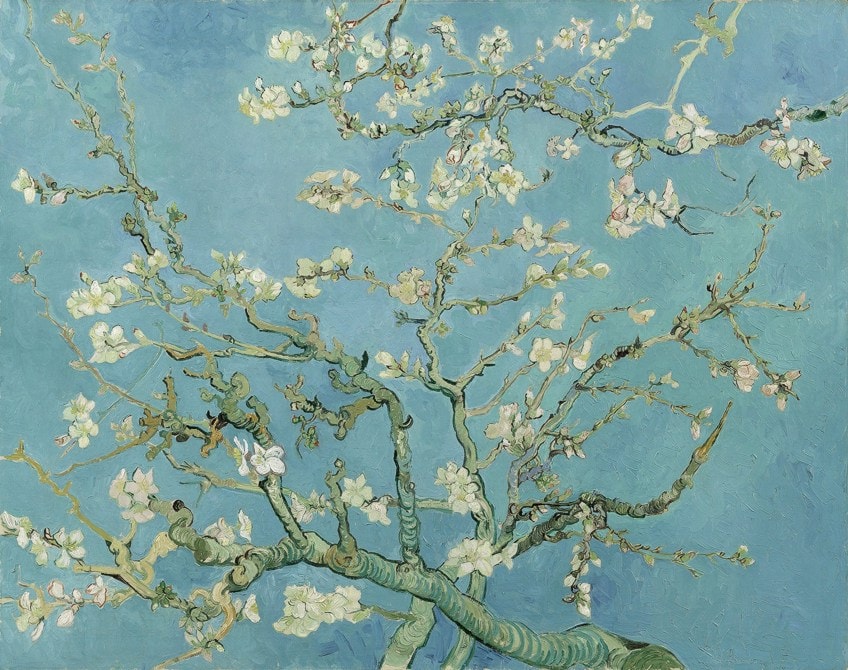
Formal Analysis: A Brief Compositional Overview
The formal analysis will start with a visual description of Irises by Vincent van Gogh, as well as how it is composed according to color, texture, line, shape, form, and space, which are known as art elements.
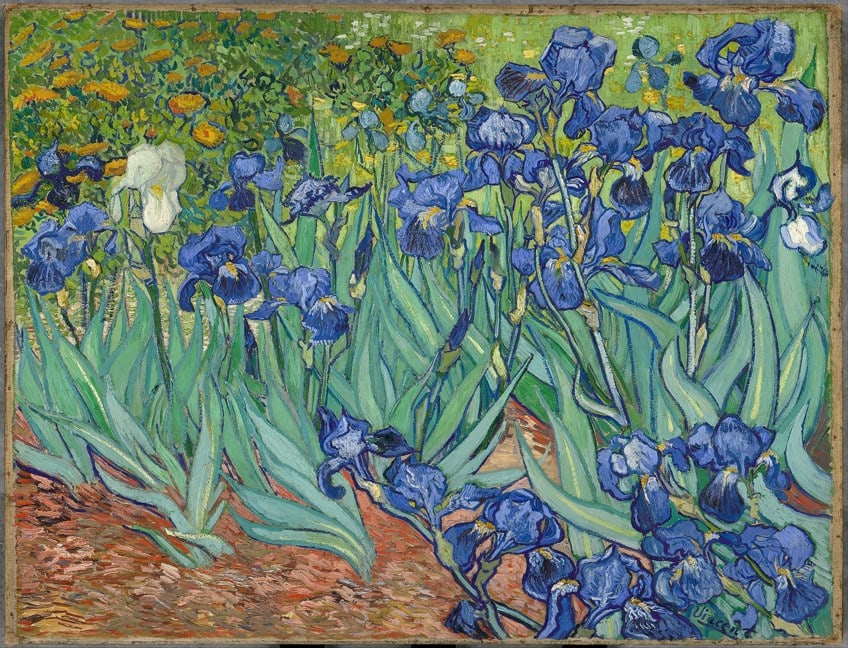
Subject Matter: Visual Description
Vincent van Gogh’s Irises painting depicts a composition filled with flowers. There is no sign of a sky, mountains, or a building, but only several purple iris flowers, most of which are positioned and seemingly clumped into the upper and lower right-hand side of the composition.
To the left, in the foreground, is a patch of open ground, which creates a subtle contrasting effect.

The middleground is mostly green and composed of the vertical leaves of the iris plants. Towards the background, in the upper left-hand side of the composition, is a white iris blossom that stands out among the purple flowers. The background is composed of a green garden, depicting what appears to be a bed of orange blossoms – or orange marigolds – to the left.
To the right is what appears to be fine green grass with several white flowers scattered here and there.

Color
Vincent van Gogh’s color scheme in his Irises painting consists mostly of cooler greens for the foliage and blue and violet for the flowers (reportedly, Van Gogh initially utilized a purple/violet paint color, which faded over the years and appeared blue). There are areas of warmer yellows and oranges for the flowers in the background, as well as earthier colors like reds and what appear to be shades of brown.
Although there appears to be a contrast of cool and warm colors, as well as complementary colors as seen in the blues and oranges, there is nonetheless a color harmony. In other words, the composition appears appealing to look at and there are no areas of clashing colors.
Line
Line as an art element can include the outline or borders of subject matter as well can be different types, for example horizontal, vertical, thick, thin, short, long, or diagonal and curvy. It moves from one point to the other. In the Irises painting, Van Gogh utilized thick outlines or borders for parts of the composition, namely the leaves, the flower stalks, and the flowers. This also emphasizes the flowers and makes them stand out in the foreground.
Additionally, this was also another characteristic of Japanese woodblock prints, in which subject matter would appear with visible outlines.
Texture
In the Irises painting, Vincent van Gogh utilized a variety of rich textures through his brushstrokes, and if you look closely, you will notice the different types that match the subject matter. For example, note the longer brushstrokes for the leaves and the short and choppy brushstrokes for the flowers.
Some brushstrokes have been thickly applied, notably for the flowers, but there are areas where the brushstrokes appear thinner in their application, as in parts of the white flower as well as various scattered areas around the canvas.
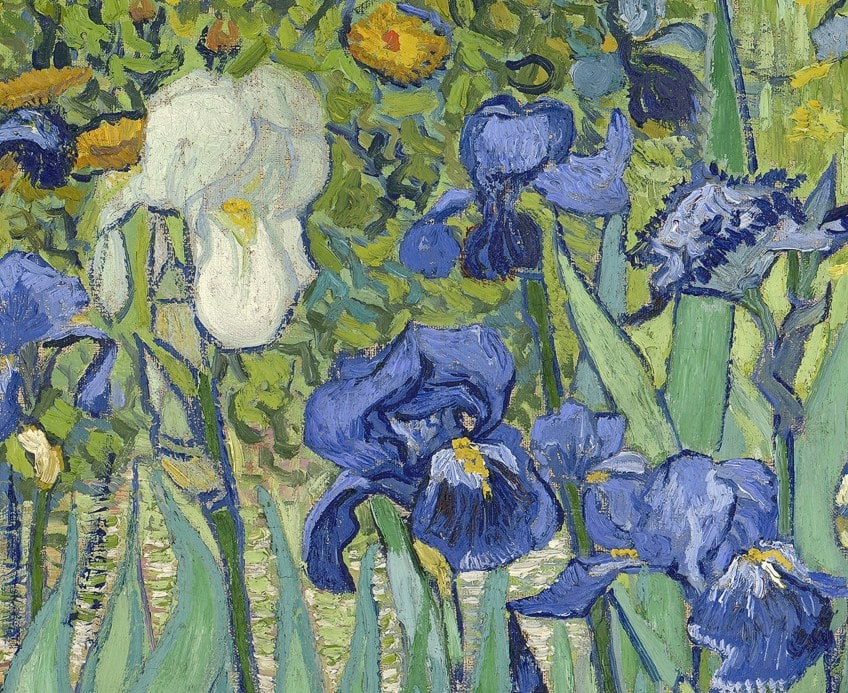
Shape and Form
There are mainly organic shapes (these simply mean they are more naturalistic and follow the forms of nature compared to more geometric or “artificial” shapes and forms) in Irises by Vincent van Gogh. Examples of organic shapes include the free-flowing shape of the flowers and their petals, the rounded, and seemingly amoeboid shapes of the flowers in the background, as well as the more elongated and curved, and limber shapes of the leaves.
Furthermore, although the composition is not rendered in strict realism, there is a naturalism inherent in the overall form of the subject matter. In other words, it is based on nature and specifically flowers.
Space
Space as an element of art includes positive or negative space, but it is also the “area” around the compositional space (as it is widely described). In Irises, Vincent van Gogh filled the right foreground space with flowers, leaving a smaller open space to the left foreground, which creates a contrasting effect.
Furthermore, the background is also filled with greenery and flowers, leaving little open space to suggest anything else like the sky, the distant landscape, or even houses or buildings. Van Gogh focuses on only a part of what is the landscape or garden. Space also suggests depth and three-dimensionality, and here, Van Gogh utilizes scale to portray spatial depth, as seen in the flowers in the foreground, which appear larger compared to the flowers in the background, which diminish in size and thus are further away.
The cropped irises in the foreground and the somewhat slanted positioning of the subject matter as well as the close-up viewpoint are all suggestive of the artist’s influence from the Japanese woodblock prints style.

Van Gogh Breathing “Air and Life”
Vincent van Gogh’s life can be viewed as one that had many ups and downs and he experienced mental difficulties that ultimately led to his death; he reportedly shot himself and died a couple of days later. He started his art career in his late twenties and did not achieve a level of fame like other artists of the time, however, posthumously he became a household name.
“Irises” by Vincent van Gogh has been viewed as an emotionally lighter composition compared to his other paintings, which seemingly hold a more emotional charge, also considering the circumstances in the artist’s life. However, regardless of the difficulties that Van Gogh experienced, making art was almost like a doorway for him, breathing “air and life” into what seemed to be dark and stifling reality, and “Irises” is just one of the hundreds that convey Van Gogh’s love and passion, not only for color, but nature and life.
Frequently Asked Questions
Who Created the Irises Painting?
The famous Post-Impressionist Vincent van Gogh painted the oil on canvas Irises (1889) when he stayed at the Saint-Paul mental asylum in 1889. He lived there for around a year after having had several mental breakdowns. He found inspiration from the garden around him as well as from the natural landscape.
How Many Irises Paintings Are There by Vincent Van Gogh?
Vincent van Gogh reportedly painted four versions of the iris flowers in 1889, namely Irises (1889), Iris (1889), and two still life paintings of the iris flowers in vases, namely, Bouquet of Irises (1890) and Irises in a Vase (1890).
Where Is Vincent van Gogh’s Irises Painting?
Irises (1889) by Vincent van Gogh is housed at the J. Paul Getty Museum in Los Angeles, California, the United States of America. It was sold to the museum through a private sale in 1990 and reportedly, the price has not been communicated.
Alicia du Plessis is a multidisciplinary writer. She completed her Bachelor of Arts degree, majoring in Art History and Classical Civilization, as well as two Honors, namely, in Art History and Education and Development, at the University of KwaZulu-Natal, South Africa. For her main Honors project in Art History, she explored perceptions of the San Bushmen’s identity and the concept of the “Other”. She has also looked at the use of photography in art and how it has been used to portray people’s lives.
Alicia’s other areas of interest in Art History include the process of writing about Art History and how to analyze paintings. Some of her favorite art movements include Impressionism and German Expressionism. She is yet to complete her Masters in Art History (she would like to do this abroad in Europe) having given it some time to first develop more professional experience with the interest to one day lecture it too.
Alicia has been working for artincontext.com since 2021 as an author and art history expert. She has specialized in painting analysis and is covering most of our painting analysis.
Learn more about Alicia du Plessis and the Art in Context Team.
Cite this Article
Alicia, du Plessis, ““Irises” by Vincent van Gogh – Studying the Famed “Irises” Painting.” Art in Context. November 17, 2022. URL: https://artincontext.org/irises-by-vincent-van-gogh/
du Plessis, A. (2022, 17 November). “Irises” by Vincent van Gogh – Studying the Famed “Irises” Painting. Art in Context. https://artincontext.org/irises-by-vincent-van-gogh/
du Plessis, Alicia. ““Irises” by Vincent van Gogh – Studying the Famed “Irises” Painting.” Art in Context, November 17, 2022. https://artincontext.org/irises-by-vincent-van-gogh/.






